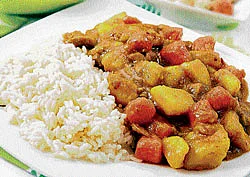
About 12 years ago, the now ubiquitous fried chicken kabab was available in this one rinky-dink restaurant in Fraser town. People flocked there from all over the city, just to sink their teeth into the juicy, artery clogging, dark red piece of heaven. These days, however, this red piece is available so easily, in so many places and is ordered with such frequency, that it’s fair to bestow upon it, the title “Bangalore’s most popular eating-out dish”. And though they might seem unrelated, the popularity-explosion that the kabab enjoyed over the turn of the century is a little bit like the transformation that Mangalorean cuisine is going through at the moment.
Five years ago, there was one Mangalorean restaurant in the city. Cut to the present, and not only has that once a hole-in-the-wall been transformed into a two-storey, marble floored monstrosity, with exorbitant prices and a dip in quality to match, but it also seems that you can’t throw a stone in the air without it hitting a restaurant specialising in “costal” cuisine. Now I’m as much a sucker as the next person when it comes to the super sinful chicken ghee roast and the rawa-fried kaane, which most of these restaurant menus are centred around, but the fact is that there is so much more to Mangalorean cuisine than what you see on the current restaurant menu.
The reason why Mangalorean cuisine is so diverse is because the region itself is home to so many different communities, each with its own language and customs, each churning out its own brand of gastronomic delights, as individual and distinct from each other, as they are from the fare produced in other parts of the country.
You have the Tulu speaking Bunts, inventors of the fiery, tamarind-flavoured pulimunchi that, if rightly prepared, should set both tongue and bowel on fire. There are the Saraswat Brahmins, strict vegetarians whose pahtrades (colocasia leaves stuffed with rice) are to die for. The Moplas, Mangalore Muslims with Arab blood in their veins, bring a fabulously spicy mutton biryani to the mix. And, finally, there are the Mangalore Christians, avid red-meat eaters and inventors of the pork sorpotel and the sanna-dukra maas, a combination of toddy fermented idlis and pork cooked with bafat masala, that is rightly served at every wedding, christening and birthday.
There are some factors of commonality between the cuisines. One, of course, is the extensive use of coconut, curry leaves, chilli, ginger, garlic, tamarind, kokum and raw mango, that make the list of preferred ingredients. Another is the use of a wide range of unusual ingredients. I’ve already mentioned the colocasia leaves, that are turned into the mouth-watering pathrades, but that is just the start. Mangaloreans also use raw banana, bamboo shoot, green jackfruit, breadfruit, a sweet cucumber called taute, and vine spinach called basale in Tulu and valchebaji in Konkani, to create dishes that are unforgettable in their authenticity.
The following is my mother’s recipe for pork bafat. It’s a family secret.
Pork Bafat
Ingredients: Pork–1.5 kgs,cut into 2 square cm cubes, onion–750 gm, cut into 2.5 square cm cubes, garlic – 1 and a half pods, finely-chopped, ginger–thumb sized piece – finely chopped, green chillies – 8, slit length-wise, cloves – 10, bay leaves – 6, cinnamon – 4 sticks.
Bafat Masala: Red Kashmiri chillies – 8, coriander seeds – 2 teaspoons, cumin seeds – 1 teaspoon, turmeric powder – half a teaspoon, pepper corns – 10, tamarind – lemon sized piece, salt – to taste.
Method: Grind the Bafat Masala down to a paste. Mix the first set of ingredients together in a saucepan and place on a low flame. Cook for 10 to 15 minutes. Add the ground masala and salt and stir. Cook, covered, until the fat on the pork is edible. Taste and add vinegar for extra sourness and salt if necessary.
Tip: The pork should ideally have a 1:2 ratio between the fat and the meat. The more the fat, the better the flavour.
